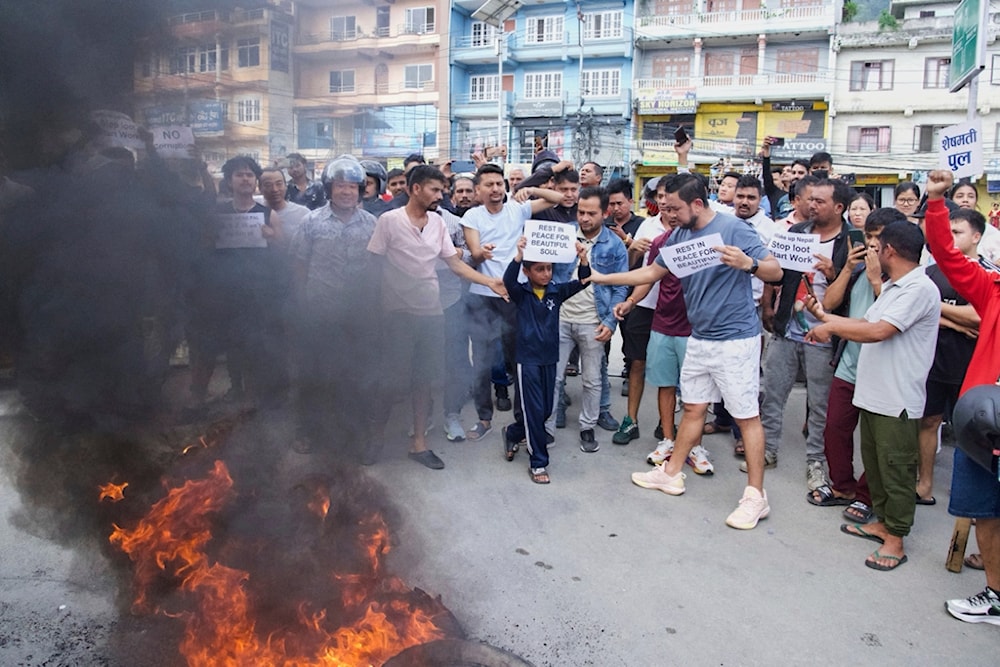Nepal PM resigns despite ending social media ban amid deadly protests
Deadly protests in Nepal expose deep public anger at what protesters see as corruption and economic stagnation, with youth leading calls for accountability.
-

Protesters burn tires violating the curfew orders in Kathmandu, Nepal, Tuesday, Sept. 9, 2025, after Nepal’s government lifted its ban on social media platforms after violent street protests. (AP)
Nepal Prime Minister K.P. Sharma Oli resigned on Tuesday as anti-corruption demonstrators defied an indefinite curfew and clashed with police, a day after 19 people died in violent protests triggered by a social media ban.
But there was no let-up in the protests on Tuesday, forcing Oli to quit and plunging Nepal into fresh political uncertainty.
On Monday, Nepal’s government reversed a ban on 26 major social media apps and messaging services on Monday, just hours after protests over the blockade intensified and left at least 19 people dead and more than 200 injured.
The demonstrations, which began in Kathmandu and spread nationwide, reflected anger over the digital restrictions as well as deeper frustrations with corruption and economic stagnation.
Footage and reports from local media showed protesters attacking the residences of senior leaders in and around Kathmandu. Authorities imposed a curfew in the capital and other major cities, while schools in Kathmandu were shut down.
Among the homes set ablaze were those of Sher Bahadur Deuba, head of the largest party Nepali Congress, President Ram Chandra Poudel, Home Minister Ramesh Lekhak, and Communist Party of Nepal leader Pushpa Kamal Dahal.
Communications Minister Prithvi Subba Gurung confirmed the rollback, stating, “We have withdrawn the shutdown of the social media. They are working now.” The reversal came amid escalating unrest, as protesters surged toward the parliament complex in the capital.
Thousands of young Nepalese, dubbed the “Gen Z” movement, took to the streets to denounce both the social media ban and what they see as entrenched government corruption. Student Yujan Rajbhandari, 24, said, “We are protesting against corruption that has been institutionalised in Nepal.”
Violence in Kathmandu, beyond
In the capital, demonstrators breached barricades at parliament, set fire to an ambulance, and clashed with police, who used water cannons, batons, and rubber bullets. The army was also mobilized, and a curfew was imposed. Similar confrontations erupted in smaller cities, leaving authorities struggling to contain the unrest.
Amnesty International reported that live ammunition was used, resulting in fatalities and serious injuries among protesters. Police confirmed 19 deaths and hundreds of injuries. Amnesty stressed that “law enforcement agencies must only use force where absolutely necessary and it must be strictly proportionate to the legitimate aim sought to be achieved.”
Prime Minister KP Sharma Oli condemned the violence, attributing it to “infiltration from different selfish centres.” Following the unrest, the home minister resigned. The government announced plans to investigate the violence, provide relief to the families of the deceased, and ensure free medical treatment for the injured.
Ongoing unrest
Even after the ban was lifted, anti-corruption demonstrations continued into Monday night and Tuesday morning. Student Ikshama Tumrok, 20, described the protests as resistance to the “authoritarian attitude” of the government, citing the social media ban as just one example of overreach.
The restrictions stemmed from new rules requiring platforms to register, establish points of contact, and designate resident grievance and compliance officers.
Major platforms, including Facebook, Instagram, WhatsApp, YouTube, Tencent, Snapchat, Pinterest, and X, were initially blocked for missing the registration deadline.
Nepal had previously blocked Telegram in July and lifted a nine-month ban on TikTok last August after the platform complied with local regulations.
Authorities cited concerns over fake accounts, hate speech, and other criminal activity on these platforms.

 4 Min Read
4 Min Read








